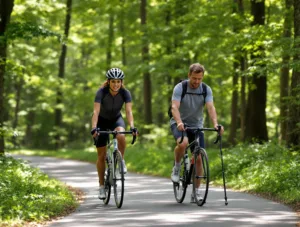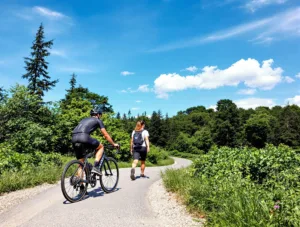Does Cycling Help Get Rid of Belly and Butt Fat? Targeting Localized Fat and Exercise Effectiveness
Introduction
In the pursuit of a leaner physique, many people wonder whether cycling can effectively reduce stubborn fat in areas like the belly and butt. With obesity rates rising and sedentary lifestyles becoming more common, finding efficient ways to burn fat is a top priority for health-conscious individuals. Cycling, a popular low-impact cardiovascular exercise, is often touted as an effective fat-burning activity. But does it specifically target belly and butt fat, or is fat loss more generalized?
This article explores the science behind fat loss, the role of cycling in burning calories, and whether it can help trim down problem areas. We’ll also examine the myth of spot reduction, compare cycling with other exercises, and provide practical advice for maximizing fat loss through cycling and complementary strategies.
Understanding Fat Loss: The Myth of Spot Reduction
How the Body Burns Fat
Fat loss occurs when the body burns more calories than it consumes, leading to a caloric deficit. The body then taps into fat stores for energy. However, where fat is lost first depends on genetics, hormones, and overall body composition.
Why Spot Reduction Doesn’t Work
Many people believe that targeting specific areas (like the belly or butt) with certain exercises will burn fat in those regions. However, scientific research consistently disproves this idea. A study published in the Journal of Strength and Conditioning Research found that abdominal exercises alone did not reduce belly fat more than general cardio. Instead, fat loss happens uniformly across the body based on individual predispositions.
Implications for Cycling
Since cycling is a full-body cardiovascular workout, it contributes to overall fat loss rather than spot reduction. While it strengthens the legs and glutes, it doesn’t directly “melt” fat in those areas—instead, it helps create the caloric deficit needed for fat loss.
Cycling for Fat Loss: How Effective Is It?
Caloric Burn and Weight Loss
Cycling is an excellent calorie-burning exercise. The exact number of calories burned depends on intensity, duration, and body weight:
- Moderate cycling (12-14 mph): 300-500 calories per hour
- Vigorous cycling (16-20 mph): 600-1000 calories per hour
Consistent cycling, combined with a healthy diet, can lead to significant fat loss over time.
Impact on Belly Fat
Visceral fat (deep belly fat) is particularly harmful, linked to heart disease and diabetes. High-intensity cycling can help reduce visceral fat by:
- Increasing metabolic rate
- Improving insulin sensitivity
- Promoting overall fat oxidation
A study in Medicine & Science in Sports & Exercise found that regular cycling significantly reduced waist circumference in participants.
Impact on Butt Fat
Cycling engages the glutes, hamstrings, and quadriceps, leading to muscle toning. While it doesn’t directly burn butt fat, it can:
- Strengthen and shape the glutes
- Improve overall body composition
- Enhance fat loss when combined with resistance training
Maximizing Fat Loss with Cycling
1. High-Intensity Interval Training (HIIT) on the Bike
HIIT cycling alternates between short bursts of maximum effort and recovery periods. Studies show HIIT burns more fat in less time compared to steady-state cardio.
Example Workout:
- Warm-up: 5 minutes easy cycling
- Sprint: 30 seconds at maximum effort
- Recovery: 1 minute slow cycling
- Repeat for 20-30 minutes
2. Long-Distance Endurance Cycling
Steady-state cycling at a moderate pace for 60+ minutes improves endurance and burns fat efficiently, especially when done in a fasted state (e.g., morning before eating).
3. Incorporate Hill Climbs and Resistance
Riding uphill or increasing resistance engages more muscle fibers, boosting calorie burn and strengthening the lower body.
4. Combine Cycling with Strength Training
Since muscle burns more calories at rest, adding strength exercises (squats, lunges, deadlifts) enhances fat loss and prevents muscle loss during weight reduction.
Complementary Strategies for Fat Loss
1. Nutrition Matters Most
No amount of cycling will outwork a poor diet. Key dietary tips:
- Prioritize protein to preserve muscle
- Reduce refined sugars and processed foods
- Eat fiber-rich foods for satiety
- Stay hydrated
2. Get Enough Sleep
Poor sleep disrupts hormones (leptin and ghrelin), increasing hunger and fat storage. Aim for 7-9 hours per night.
3. Manage Stress
Chronic stress raises cortisol, which promotes belly fat storage. Incorporate relaxation techniques like yoga or meditation.
Cycling vs. Other Exercises for Fat Loss
| Exercise | Calories Burned (per hour) | Targets Belly/Butt Fat? | Pros | Cons |
|---|---|---|---|---|
| Cycling | 300-1000 | No (general fat loss) | Low-impact, builds leg muscle | Less upper-body engagement |
| Running | 500-1000 | No (general fat loss) | High calorie burn | High impact on joints |
| Swimming | 400-700 | No (general fat loss) | Full-body workout, low-impact | Less accessible for some |
| Strength Training | 200-500 | No (but builds muscle) | Increases metabolism long-term | Slower immediate calorie burn |
Final Verdict: Can Cycling Help Reduce Belly and Butt Fat?
Cycling is an effective tool for fat loss, but it doesn’t exclusively target the belly or butt. Instead, it contributes to overall fat reduction when combined with a caloric deficit, strength training, and proper nutrition. For best results:
- Mix HIIT and endurance cycling for maximum calorie burn.
- Add resistance training to build muscle and boost metabolism.
- Follow a balanced diet to support fat loss.
While you can’t choose where fat disappears first, cycling will help you achieve a leaner, stronger physique over time. Consistency and a holistic approach are key to seeing results.
Conclusion
Cycling is a powerful exercise for burning calories, improving cardiovascular health, and toning muscles—but it won’t magically erase belly or butt fat alone. Fat loss requires a comprehensive strategy involving diet, varied workouts, and lifestyle adjustments. By incorporating cycling into a well-rounded fitness plan, you can achieve sustainable fat loss and a healthier, more defined body.
Final Advice: Stay patient, stay consistent, and remember that fat loss is a journey—not an overnight transformation. Happy cycling!









Add comment